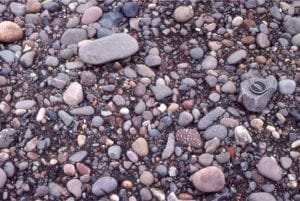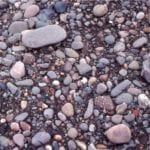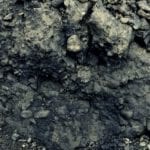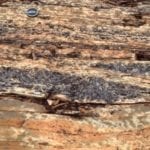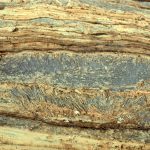Texture in a rock describes the relationship of its components – grains, minerals, other chunks of rock – to one another. In detrital sediments and sedimentary rocks, a distinction is made between clasts that form the framework (silt, sand, grit, pebble, cobble, boulder), and detrital sediment that is the matrix – matrix resides in the spaces between grains and usually consists of very fine-grained sediment, such as clays and silt. Detailed description of the matrix usually requires a microscope.
We can describe the framework in terms of the size (sand, cobble etc.) and shape of individual clasts (sherical, oblate, angular versus rounded), the proportions of different clast sizes (e.g. sorting), and the proportion of framework to matrix. These are all useful descriptors of a sediment, but they can also provide valuable information on depositional processes, such as:
- the degree of sediment reworking during transport (e.g. beach versus glacial diamitite),
- depositional energy (e.g. river channel versus floodplain, beach versus estuary),
- the removal, or winnowing of lighter, or hydraulically more buoyant mineral grains (e.g. micas), or
- removal of mechanically less stable grains or minerals – for example quartz is mechanically more stable than feldspar because the latter usually has good cleavage.
Sedimentary fabric refers to detrital components that impart some kind of directionality to rock and sediment. It can be thought of as a vector, that has both magnitude (size, shape) and direction (texture only has qualities like size, shape, proportion and so on). Thus, the alignment of clasts or fossils imparts a fabric (e.g. pebble imbrication in a channel, or current-aligned fossils).
Together, texture and fabric are important additions to a geologists toolbox, for description and interpretation.
This link will take you to an explanation of the Atlas series, the ownership, use and acknowledgment of images. There, you will also find links to the other categories.
Click on the image for an expanded view, then the ‘back page’ arrow to return to the Atlas.
The images:
Beach gravels (Left, Haumoana, NZ; Right, Fundy Bay, Nova Scotia: both have clast-supported frameworks of well rounded, oblate to platey pebbles and cobbles. Their texture and lack of fine matrix are in keeping with the high wave energy along these coasts.
 Beach storm ridge shell accumulations, clast (shell) supported. The shells are predominantly gastropods, including abundant Struthiolaria. There is no obvious preferred orientation of shells and shell fragments. Mangawhai Heads, NZ
Beach storm ridge shell accumulations, clast (shell) supported. The shells are predominantly gastropods, including abundant Struthiolaria. There is no obvious preferred orientation of shells and shell fragments. Mangawhai Heads, NZ
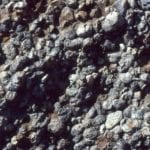 Exhumed surface of a Jurassic, marine, debris flow. Pebbles of radiolarian chert are all well rounded, and most participate in a clast-supported framework. Rounding of the pebbles must have taken place in a shallower water environment, probably fluvial. This was probably a highly fluid debris flow. Bowser Basin, northern British Columbia.
Exhumed surface of a Jurassic, marine, debris flow. Pebbles of radiolarian chert are all well rounded, and most participate in a clast-supported framework. Rounding of the pebbles must have taken place in a shallower water environment, probably fluvial. This was probably a highly fluid debris flow. Bowser Basin, northern British Columbia.
Contrasting debris flow textures. Left; matrix-supported clasts of radiolarian chert and mudstone rip-ups – this was a very muddy, cohesive debris flow. Right; mixed last-supported and matrix-supported clasts in a less cohesive, more fluid debris flow. Bowser Basin, northern British Columbia.
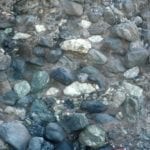 Bouldery debris flow, with mixed clast- and matrix-supported frameworks. Dana Point, California.
Bouldery debris flow, with mixed clast- and matrix-supported frameworks. Dana Point, California.
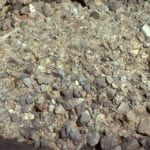 Lower Miocene volcaniclastic debris flow, mostly matrix-supported but pockets of clast-supported frameworks. Waitakere Volcanic arc, west Auckland.
Lower Miocene volcaniclastic debris flow, mostly matrix-supported but pockets of clast-supported frameworks. Waitakere Volcanic arc, west Auckland.
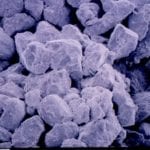 Scanning electron microsope image of a moderately well-sorted sandstone, Ellerslie Fm, Alberta. Sand grains show varying degrees of depositional rounding. The fuzzy surface of most grains is caused by incipient diagenetic clays (illite-kaolinite), i.e. clays formed by chemical reactions after deposition. This rock has excellent porosity and permeability. the image width spans 3mm.
Scanning electron microsope image of a moderately well-sorted sandstone, Ellerslie Fm, Alberta. Sand grains show varying degrees of depositional rounding. The fuzzy surface of most grains is caused by incipient diagenetic clays (illite-kaolinite), i.e. clays formed by chemical reactions after deposition. This rock has excellent porosity and permeability. the image width spans 3mm.
Thin section micrographs of a lithic sandstone (arenite). Left: plane polarized light, showing individual grain shapes and intergrain contacts. The blue areas are pore spaces filled with blue resin. Right: Crossed nicols, showing quartz in various stages of extinction, lithic grains (speckled), and minor potassium feldspar. Ellerslie Fm, Alberta. Most grains here are about 0.2 – 0.3mm across.
check out this and related posts for an explanation of polarizing microscopy
 Thin section micrograph, under crossed nicols of a calcite-cemented lithic sandstone, Ellerslie Fm, Alberta. The calcite has a yellow-orange colour. Most grains here are about 0.2 – 0.3mm across.
Thin section micrograph, under crossed nicols of a calcite-cemented lithic sandstone, Ellerslie Fm, Alberta. The calcite has a yellow-orange colour. Most grains here are about 0.2 – 0.3mm across.
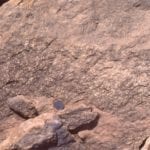 The fusulinid foraminifera incorporated into these Permian sediments, have all been aligned approximately parallel to the local paleocurrents (determined from crossbedded calcarenites). South Bay, Ellesmere Island.
The fusulinid foraminifera incorporated into these Permian sediments, have all been aligned approximately parallel to the local paleocurrents (determined from crossbedded calcarenites). South Bay, Ellesmere Island.
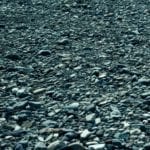 Modern river gravels containing abundant platy rock fragments that are aligned by the prevailing currents. The imbrication here indicates flow to the right.
Modern river gravels containing abundant platy rock fragments that are aligned by the prevailing currents. The imbrication here indicates flow to the right.
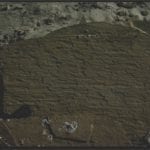 Parting lineation in laminated sandstone forms when the long axes of sand grains, in layers a few grains thick, are aligned parallel to current flow directions. The streakiness, or lines form when sandstone splits along the laminae. They are thought to form during upper flow-regime plane bed flow (high energy flow). Paleoflow in this example was either to the right or left; a decision as to which direction can only be determined from unidirectional structures.
Parting lineation in laminated sandstone forms when the long axes of sand grains, in layers a few grains thick, are aligned parallel to current flow directions. The streakiness, or lines form when sandstone splits along the laminae. They are thought to form during upper flow-regime plane bed flow (high energy flow). Paleoflow in this example was either to the right or left; a decision as to which direction can only be determined from unidirectional structures.
 Stone rosettes form on beaches where there is a plentiful supply of platy rock fragments – in this case much older shale. The flat clasts are turned edgewise by wave action, and commonly are organised into crude radiating or stacked patterns (also called edgewise conglomerate). Similar structures can form from bivalve shells. On some beaches they form extensive pavements. Somewhat similar structures have been reported from periglacial regions.
Stone rosettes form on beaches where there is a plentiful supply of platy rock fragments – in this case much older shale. The flat clasts are turned edgewise by wave action, and commonly are organised into crude radiating or stacked patterns (also called edgewise conglomerate). Similar structures can form from bivalve shells. On some beaches they form extensive pavements. Somewhat similar structures have been reported from periglacial regions.
 An example of ancient stone rosettes, or edgewise conglomerate forming extensive pavements on a Proterozoic beach (about 2 billion years old). In this example (Mavor Fm., Belcher Islands, Hudon Bay), the thin slabs consist of dolomitized lutite crusts, formed probably in a supratidal flat, and subsequently ripped up by storm waves.
An example of ancient stone rosettes, or edgewise conglomerate forming extensive pavements on a Proterozoic beach (about 2 billion years old). In this example (Mavor Fm., Belcher Islands, Hudon Bay), the thin slabs consist of dolomitized lutite crusts, formed probably in a supratidal flat, and subsequently ripped up by storm waves.
Here is a paper on these examples: Ricketts, B.D. and Donaldson, J.A. 1979: Stone rosettes as indicators of ancient shorelines: examples from the Precambrian Belcher Group, Northwest Territories; Canadian Journal of Earth Sciences, v. 16, p. 1187-1891
Bedding cross-section views of ancient, Proterozoic stone rosette beach pavements. The edgewise stacking of platy dololutite crusts is readily apparent. A bedding view of the same structures is shown above. Mavor Fm, Belcher Islands, Hudson bay.

